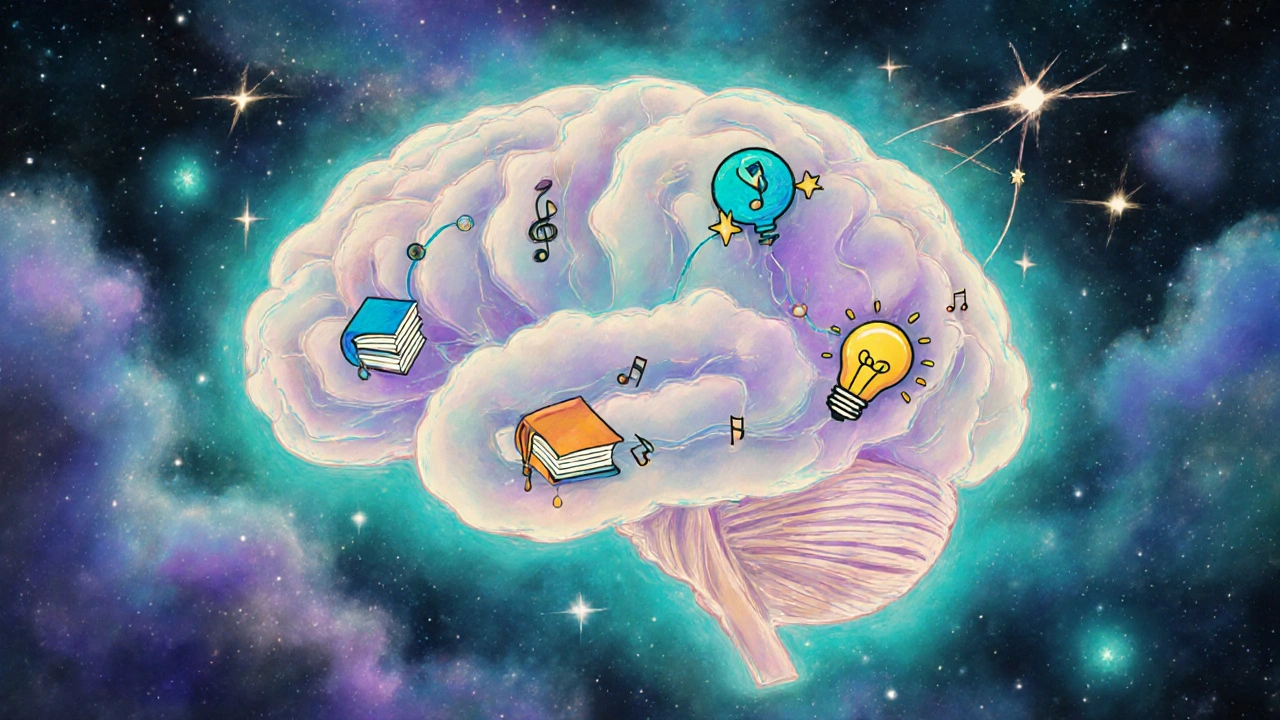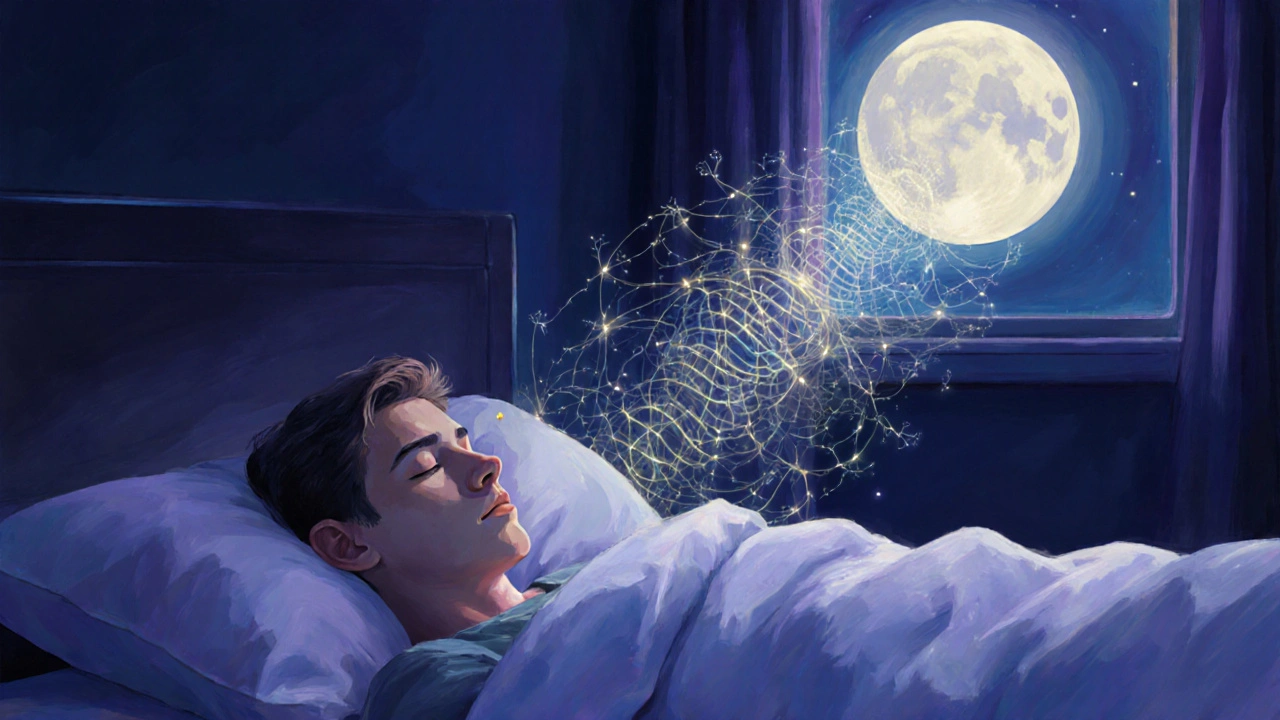Rapid Eye Movement (REM) sleep is a sleep stage that occupies roughly 20‑25% of adult sleep time, features swift eye movements, low muscle tone, and vivid dreaming. Scientific consensus links REM sleep to memory consolidation and creativity, making it a prime target for anyone looking to learn faster or think more originally.
TL;DR
- REM sleep accounts for about a quarter of a typical night and is essential for solidifying both facts and skills.
- During REM, the hippocampus and pre‑frontal cortex replay experiences, strengthening neural pathways.
- Dream imagery fuels creative insight; many inventions trace back to REM‑stage dreams.
- Sleep deprivation slashes REM duration, hurting recall, problem‑solving, and idea generation.
- Consistent bedtime, darkness, and a cool room boost REM cycles.
What Exactly Is REM Sleep?
REM sleep follows several shorter NREM (non‑rapid eye movement) periods in each 90‑minute sleep cycle. While heart rate and breathing become irregular, the brain’s electrical activity mirrors wakefulness, showing low‑frequency theta waves and bursts of high‑frequency gamma activity. This paradox - a sleeping body with a waking brain - is why REM is sometimes called "paradoxical sleep."
Researchers using polysomnography identify REM by three markers: rapid eye movements on an electro‑oculogram, muscle atonia on electromyography, and an electroencephalogram pattern resembling alertness. The stage usually peaks in the latter half of the night, meaning the longest REM bouts occur close to waking.
REM and Memory Consolidation
Memory consolidation is the brain’s process of turning fragile, short‑term traces into stable, long‑term stores. During REM, the hippocampus - the brain’s temporary filing cabinet - replays recent experiences, allowing cortical areas to integrate them into existing knowledge networks.
Studies from the 1990s onward show that participants who nap for 90 minutes (including a full REM episode) outperform awake controls on declarative tasks such as word‑pair recall. A 2022 meta‑analysis of 56 experiments found a 12‑percent boost in retention when REM duration increased by 10 minutes.
The neurochemical environment matters too. Acetylcholine levels surge in REM, promoting synaptic plasticity, while norepinephrine drops, reducing interference from new inputs. This cocktail encourages synaptic plasticity - the ability of connections between neurons to strengthen or weaken - which underlies learning.
REM as a Creativity Engine
Beyond factual memory, REM fuels the brain’s ability to make novel connections. When we dream, the pre‑frontal cortex down‑regulates logical constraints, allowing disparate ideas to mingle. Researchers term this "hyperassociativity" - a state where remote concepts link more readily.
Historical anecdotes abound: the melody for "Yesterday" reportedly came to Paul McCartney in a dream; chemist August Kekulé visualized a snake biting its tail, leading to the ring structure of benzene. Modern experiments show participants solving insight puzzles (e.g., the “nine‑dot” problem) after a REM‑rich nap solve them up to 30% faster than those who stay awake.
Neuroimaging reveals heightened activity in the hippocampus and associative visual areas during REM, supporting the blend of memory retrieval and imagination that births creative insight.
Key Neurochemical Players
Two neurotransmitter families dominate REM physiology:
- Acetylcholine - spikes during REM, enhancing cortical activation and plasticity.
- Norepinephrine - drops to near‑zero, lifting the brain’s filtering mechanisms and permitting freer ideation.
Additionally, brain‑derived neurotrophic factor (BDNF) rises after REM‑rich sleep, supporting neuronal growth and long‑term potentiation, a cellular substrate for both learning and creative thought.
Sleep Architecture: How REM Fits In
Each night’s sleep follows a predictable architecture: N1 → N2 → N3 (deep slow‑wave sleep) → REM, repeating 4‑6 times. The first REM episode is short (5‑15 minutes), but later cycles can exceed 30 minutes. The proportion of REM grows as the night progresses, making early wake‑ups especially harmful to creative processing.
Factors that shift this balance include age (children spend up to 50% of sleep in REM), alcohol (suppresses REM in the first half of the night), and certain medications like antidepressants (which may reduce REM density).

When REM Is Cut Short: Effects of Sleep Deprivation
Sleep deprivation doesn’t just make you groggy; it selectively impairs REM and therefore both memory and creativity. One night of total sleep loss can shrink REM by up to 40%, leading to a 15‑percent drop in declarative recall and a 25‑percent slowdown on insight‑based puzzles.
Chronic partial deprivation (e.g., 6‑hour nights) produces cumulative deficits. A 2021 longitudinal study of medical residents showed that those averaging less than 6 hours per night had 20% fewer REM episodes and reported lower scores on a visual‑spatial creativity test.
Importantly, the brain attempts to rebound: after a night of poor sleep, the next sleep period features “REM rebound,” where REM duration spikes. While this helps recover some function, consistency remains key for optimal learning.
Practical Ways to Maximize REM
- Keep a regular schedule. Going to bed and waking at the same time stabilizes circadian rhythms, ensuring predictable REM timing.
- Dark, cool bedroom. Light suppresses melatonin, shifting the sleep cycle earlier and shortening REM. Aim for 65°F (18°C) and blackout curtains.
- Limit alcohol after 8PM. Alcohol initially deepens N3 but later fragments REM, reducing its overall proportion.
- Exercise earlier in the day. Moderate aerobic activity raises overall sleep efficiency, indirectly boosting REM length.
- Mind‑calm before bed. Meditation or a brief journal reduces stress hormones that can disrupt REM continuity.
For learners, consider a strategic “nap‑to‑creative‑boost” schedule: a 90‑minute nap after a study session captures a full REM cycle, solidifying the material and priming the brain for insight.
REM vs. NREM: A Quick Comparison
| Aspect | REM | NREM (especially Stage3) |
|---|---|---|
| Brain activity pattern | EEG similar to wakefulness (theta & gamma) | Slow‑wave, high‑amplitude delta waves |
| Primary function | Memory consolidation of procedural & emotional info; creative integration | Physical restoration; declarative memory stabilization |
| Neurotransmitter milieu | High acetylcholine, low norepinephrine | Balanced acetylcholine, higher norepinephrine |
| Dream intensity | Vivid, narrative dreams | Rare, fragmented dreams |
| Impact on creativity | Facilitates hyper‑associative thinking | Limited direct effect |
Related Concepts Worth Exploring
If you’re intrigued by REM’s role, the next logical steps include diving into sleep hygiene practices, understanding circadian rhythm disorders, and examining how lucid dreaming can be harnessed for deliberate problem‑solving. Each of these topics builds on the mechanisms outlined here and offers actionable strategies for better mental performance.
Bottom Line
REM sleep isn’t just a nightly entertainment show; it’s the brain’s workshop for turning yesterday’s experiences into tomorrow’s insights. By protecting and enhancing REM through consistent sleep habits, you give your memory and creative mind the raw material they need to thrive.
Frequently Asked Questions
How much REM sleep do I need each night?
Adults typically get 90‑120 minutes of REM across 4‑5 cycles. This translates to about 20‑25% of total sleep time. Consistently hitting 7‑9 hours of sleep usually ensures enough REM.
Can a short nap improve my creativity?
Yes. A 90‑minute nap that includes a full REM episode can boost creative problem‑solving by up to 30% compared with staying awake, according to several sleep‑learning studies.
What foods help increase REM sleep?
Complex carbs (whole grains) and tryptophan‑rich foods (nuts, turkey) support serotonin production, which can enhance REM quality. Avoid heavy meals close to bedtime.
Why does alcohol suppress REM?
Alcohol initially deepens N3 sleep but metabolizes quickly, leading to a fragmented second half of the night where REM cycles are shortened or skipped entirely.
Is REM sleep linked to emotional regulation?
Absolutely. REM integrates emotional memories, reducing the intensity of negative affect. People with disrupted REM often report heightened anxiety and mood swings.


Post A Comment